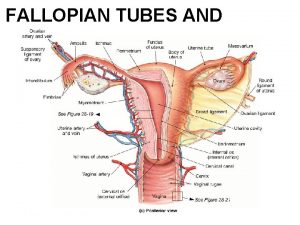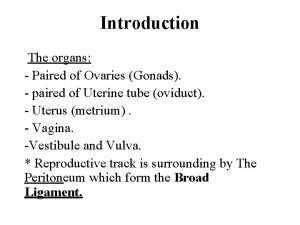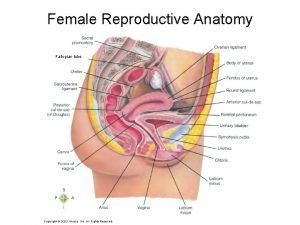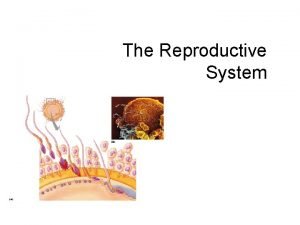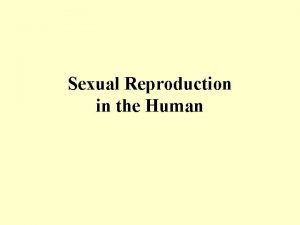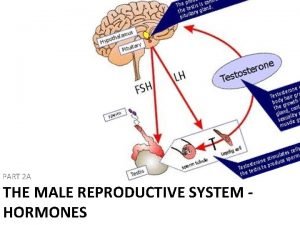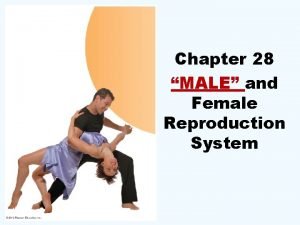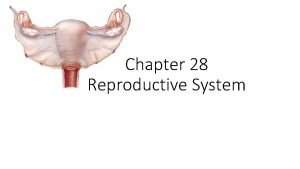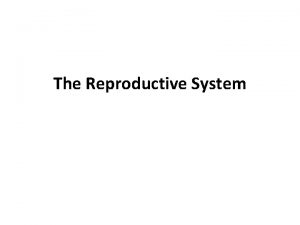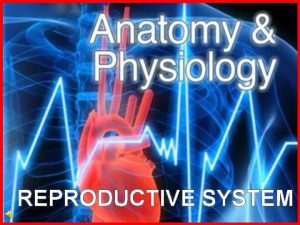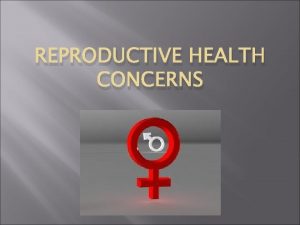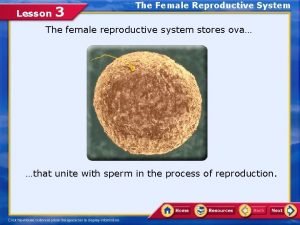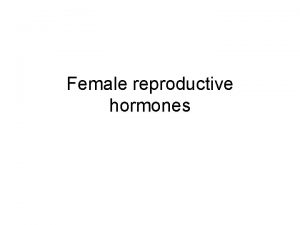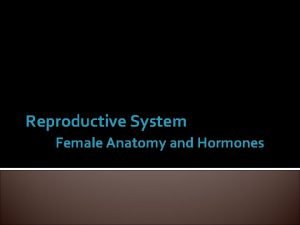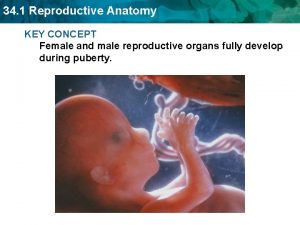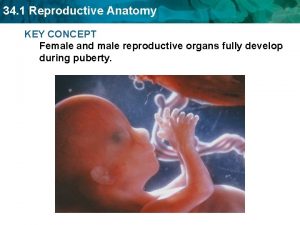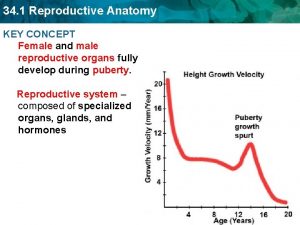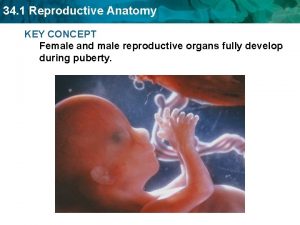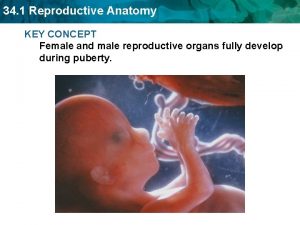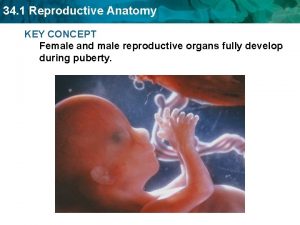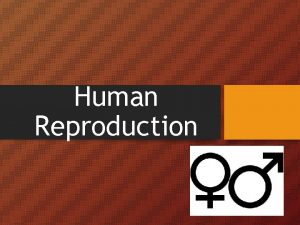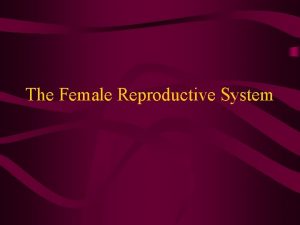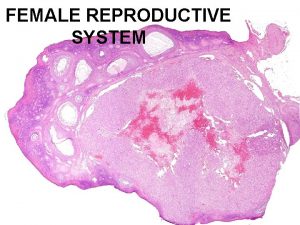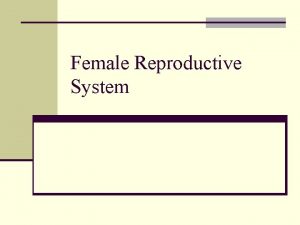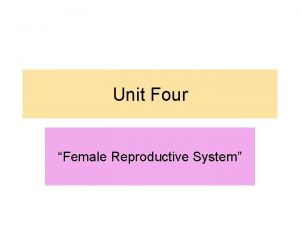34 1 Reproductive Anatomy KEY CONCEPT Female and


















- Slides: 18

34. 1 Reproductive Anatomy KEY CONCEPT Female and male reproductive organs fully develop during puberty.

34. 1 Reproductive Anatomy The female reproductive system produces ova. • There are two main functions of the female reproductive system. – produce ova, or egg cells – provide a place where a zygote develops fallopian tube ovary uterus cervix pubic bone urinary bladder urethra rectum vagina

Function: Produce ova (eggs) and prepare the body to nourish a developing embryo Uterine tube: egg transport Uterus: embryo development Cervix: entrance to uterus Vagina: birth canal Anal Canal: waste excretion Perineum: skin between anus and vagina Ovary: produces eggs Bladder: urine storage Pubic bone: part of pelvis Clitoris: external genitalia Labia minora entrance to } Labia majora vagina

34. 1 Reproductive Anatomy • Estrogen has three main functions. – develop female sexual characteristics – develop eggs – prepare uterus for pregnancy

34. 1 Reproductive Anatomy The male reproductive system produces sperm. • There are two main functions of the male reproductive system. – produce sperm cells – deliver sperm to the female reproductive system urinary bladder seminal vesicle vas deferens pubic bone prostate gland rectum penis urethra epididymis scrotum testis bulbourethral gland

Function: Produce and deliver sperm Penis: external reproductive organ Urethra: carries urine from bladder to outside of body; tube through which semen is released

Seminal vesicle: produces seminal fluid (semen without the sperm) Prostate gland: seminal fluid Bulbourethral gland: seminal fluid Vas deferens: tube for sperm transport Epididymis: sperm maturation and storage Testis: sperm production Scrotum: external sac containing testes

34. 1 Reproductive Anatomy • Testosterone has two main functions. – developing male sexual characteristics – producing sperm

34. 2 Reproductive Processes TEKS 6 G, 10 A KEY CONCEPT Human reproductive processes depend on cycles of hormones.

34. 2 Reproductive Processes TEKS 6 G, 10 A Eggs mature and are released according to hormonal cycles. • Follicle-stimulating hormone (FSH) and lutenizing hormone (LH) regulate egg production. – meiosis produces eggs and polar bodies – each egg has 23 chromosomes – meiosis is completed at fertilization potential egg Meiosis I Completed first polar body Meiosis II Completed only after sperm enters second polar body ovum (egg)

34. 2 Reproductive Processes TEKS 6 G, 10 A • FSH, LH, and estrogen stimulate the release of eggs. – follicle ruptures at ovulation – egg travels into fallopian tube – ruptured follicle becomes corpus luteum fallopian tube uterus 5 to 7 days to uterus follicle egg cell egg released ovary uterine wall corpus luteum

34. 2 Reproductive Processes TEKS 6 G, 10 A Eggs mature and are released according to hormonal cycles. • The menstrual cycle has three phases. – flow phase: endometrium sheds – follicular phase: ovulation occurs – luteal phase: corpus luteum forms

34. 2 Reproductive Processes TEKS 6 G, 10 A

34. 2 Reproductive Processes TEKS 6 G, 10 A • The menstrual cycle stops at menopause. – cycle continues until a woman’s mid-40’s or 50’s – decline in hormone levels make cycles irregular – eventually, cycle stops altogether

34. 2 Reproductive Processes TEKS 6 G, 10 A Sperm production in the testes is controlled by hormones. • Testosterone, FSH, and LH stimulate sperm production. – one sex cell divides into four sperm – each sperm has 23 chromosomes potential sperm Meiosis II 4 sperm cells

34. 2 Reproductive Processes • Sperm cells fully mature in the epididymis. – head contains acrosome – midpiece contains ATP acrosome – tail allows mobility TEKS 6 G, 10 A nucleus with 23 chromosomes head mitochondria midpiece tail

34. 2 Reproductive Processes TEKS 6 G, 10 A Fertilization occurs when a sperm cell joins an egg cell. • Sperm penetrates an egg. – membrane keeps out other sperm – nucleus of sperm joins with egg – zygote formed

34. 2 Reproductive Processes TEKS 6 G, 10 A • Multiple zygotes can result from fertilization. – identical twins from the same egg – fraternal twins from two separate eggs • Infertility makes reproduction difficult or impossible.
 Anatomy of female cow reproductive system
Anatomy of female cow reproductive system Female reproductive system anatomy
Female reproductive system anatomy Where is the vulver
Where is the vulver Fallopian tube
Fallopian tube Drawing of the male and female reproductive system
Drawing of the male and female reproductive system Male fallopian tube
Male fallopian tube Differences between male and female reproductive organ
Differences between male and female reproductive organ Sperm duct
Sperm duct Male reproductive system
Male reproductive system What are primary sexual characteristics
What are primary sexual characteristics Drawing of the male and female reproductive system
Drawing of the male and female reproductive system Hyena testicles
Hyena testicles Cartilaginous fish vs bony fish
Cartilaginous fish vs bony fish Figure of female reproductive system
Figure of female reproductive system Female reproductive system with baby
Female reproductive system with baby Female reproductive system external
Female reproductive system external Epilization
Epilization Inguinal
Inguinal Lesson 3 the female reproductive system
Lesson 3 the female reproductive system

